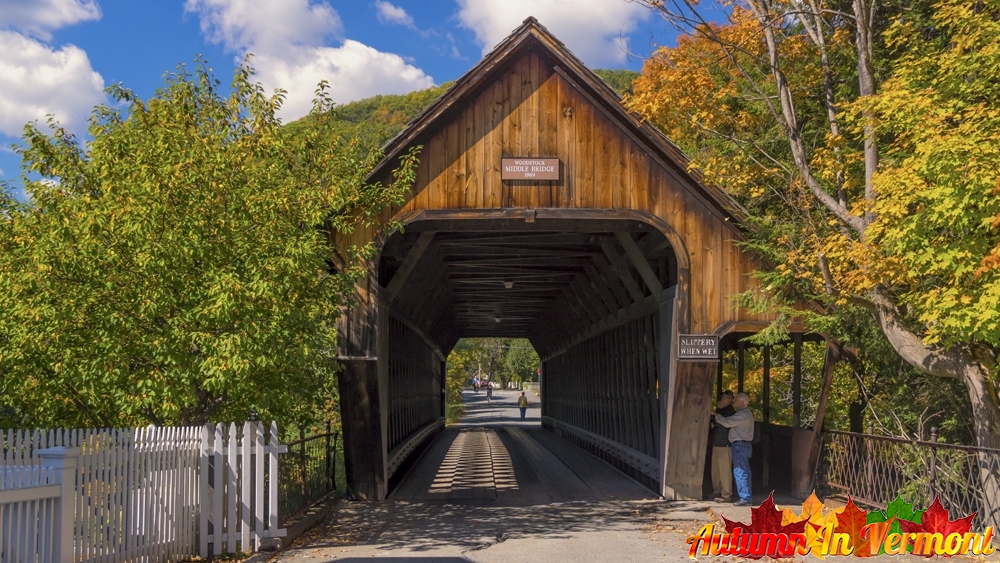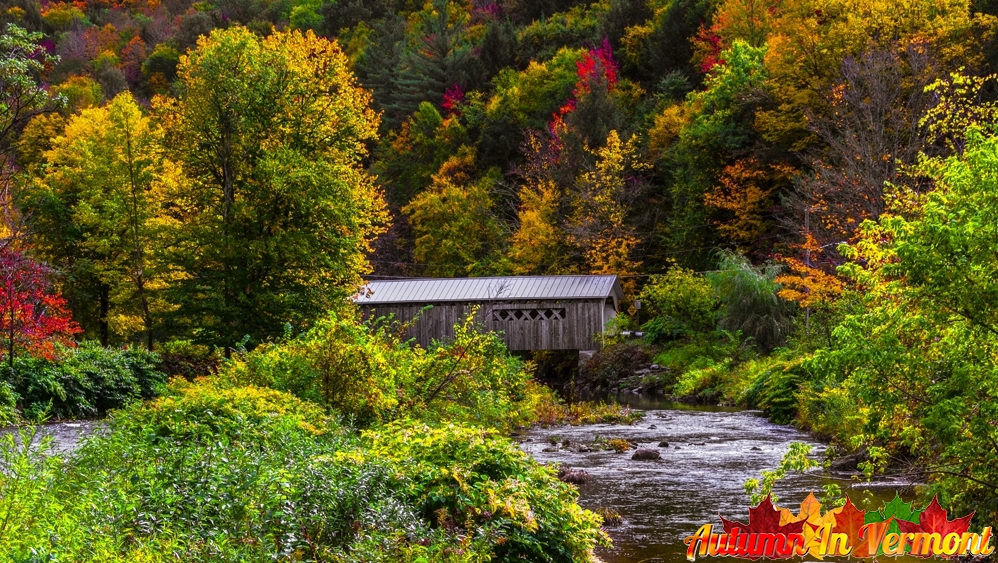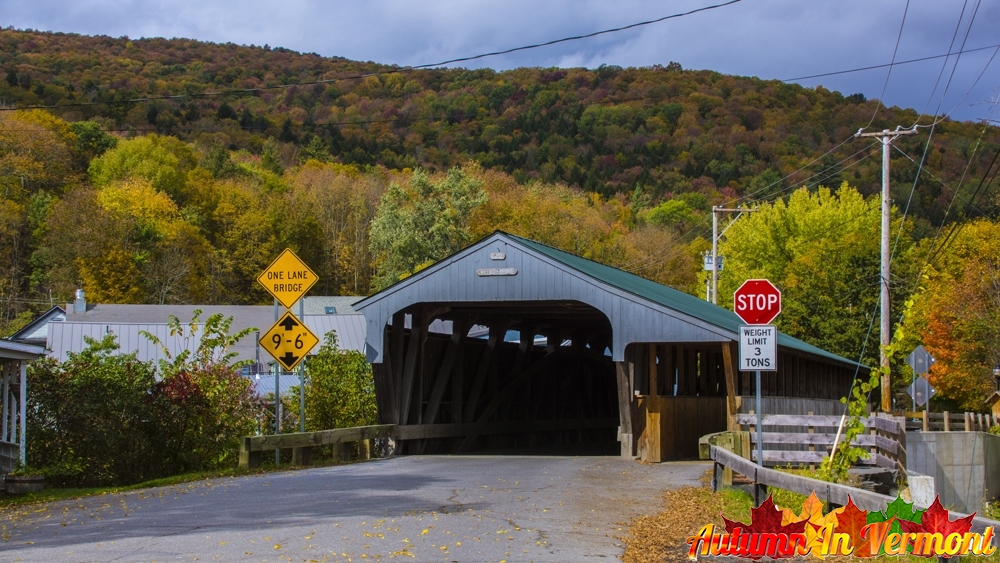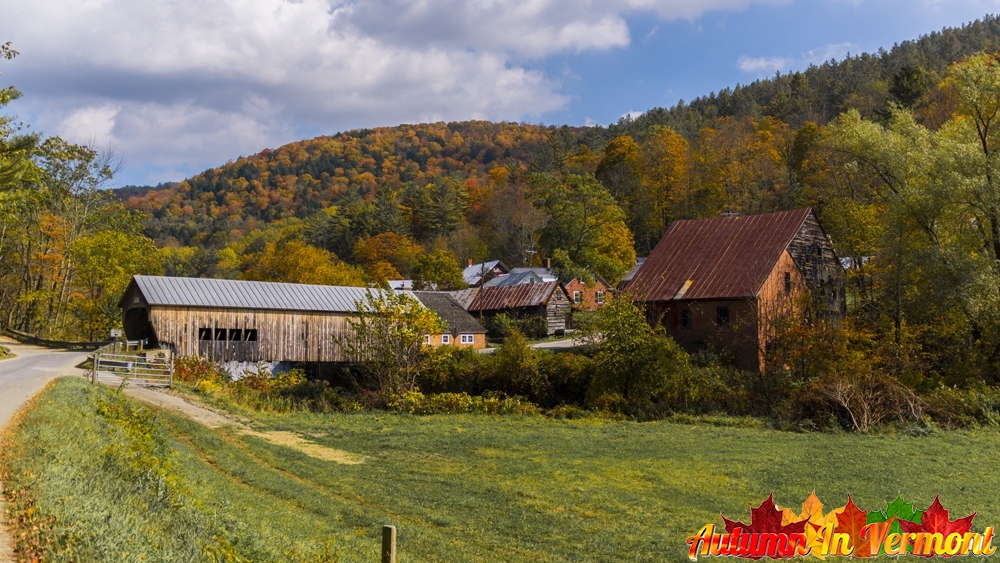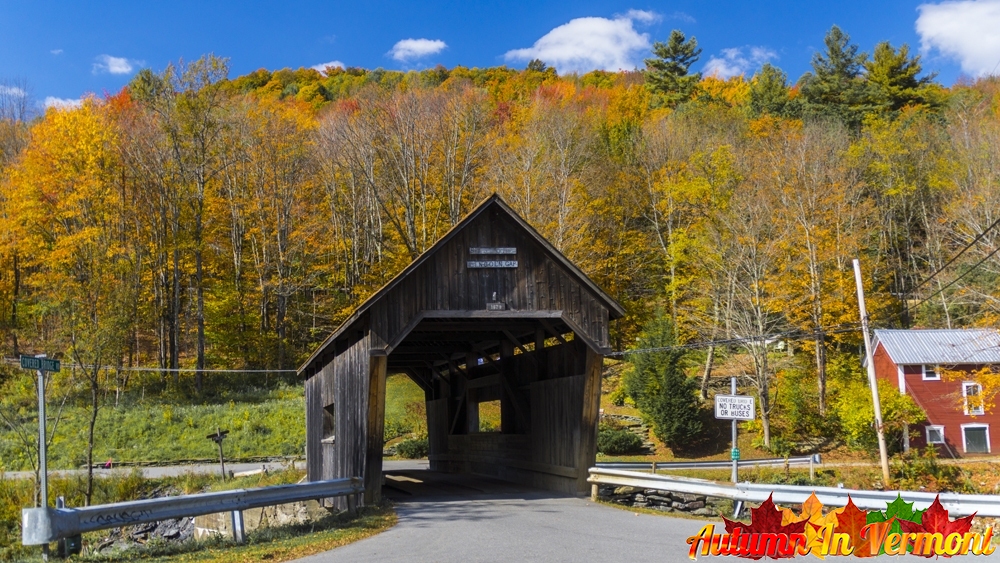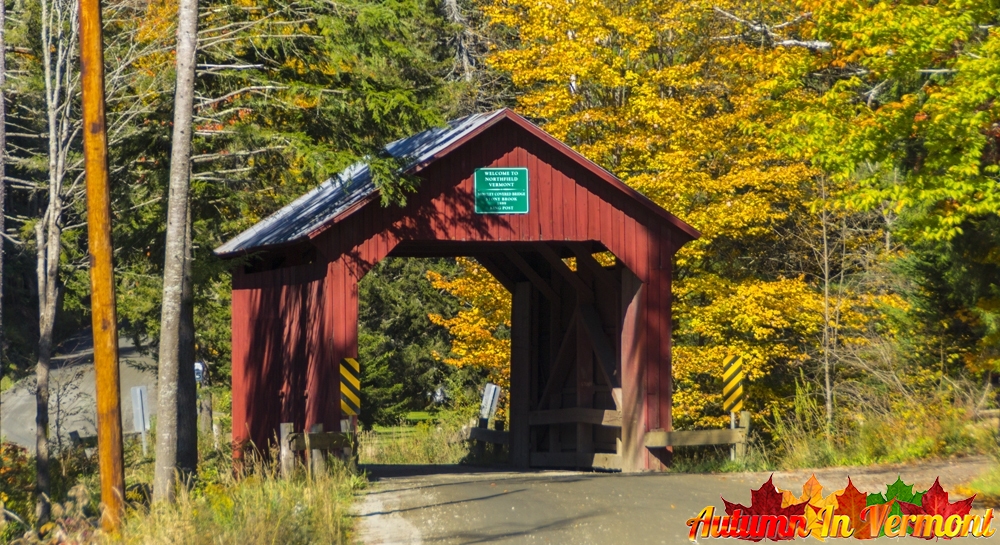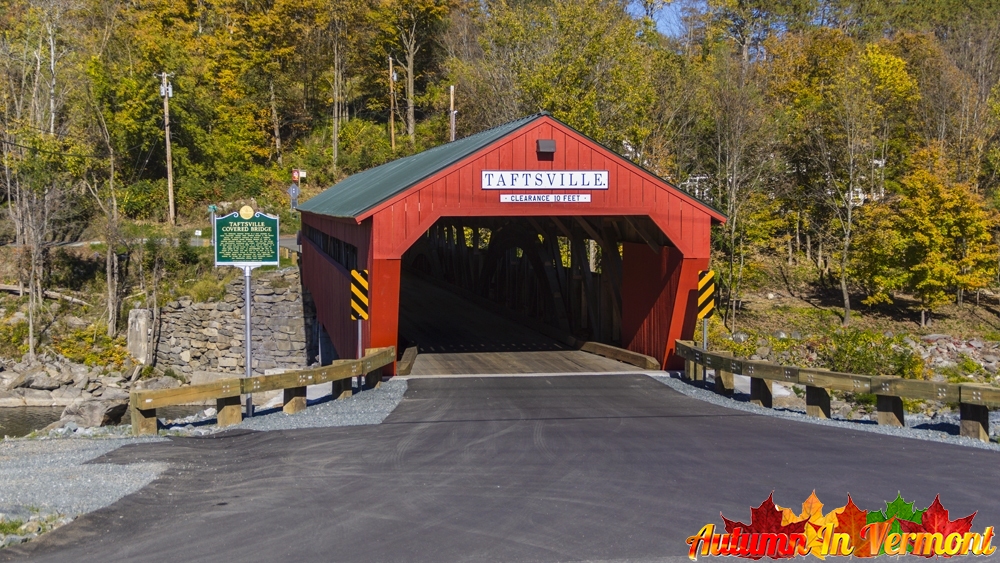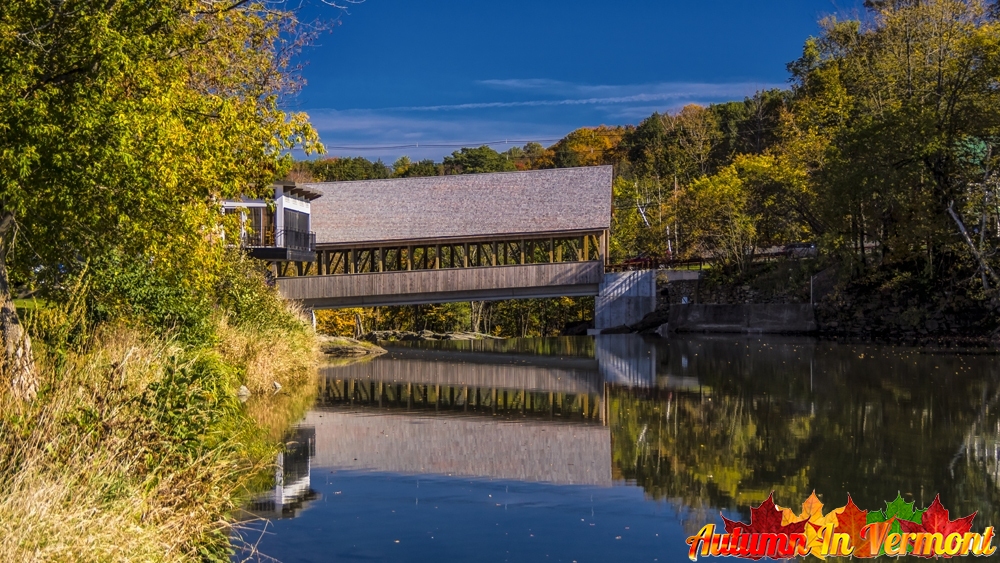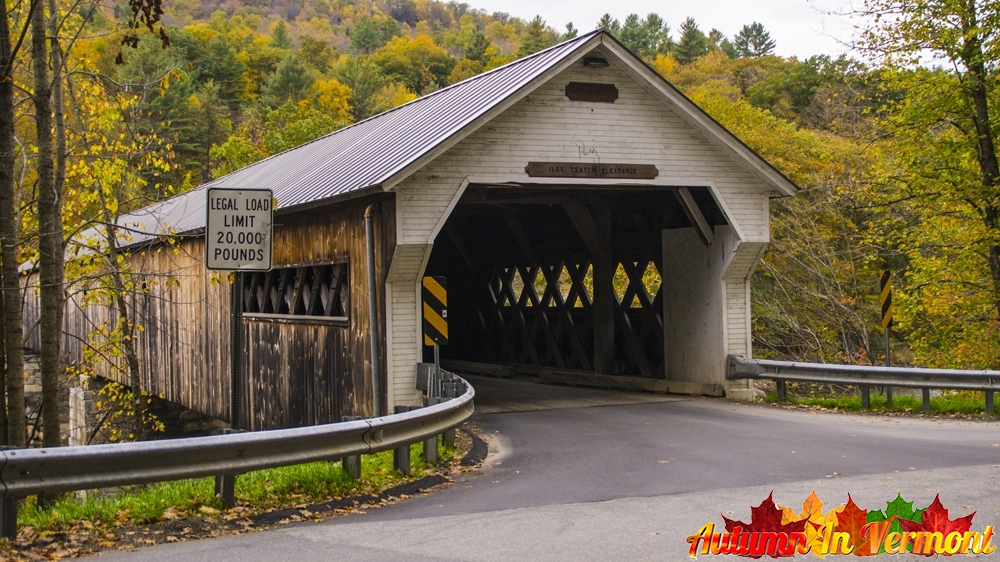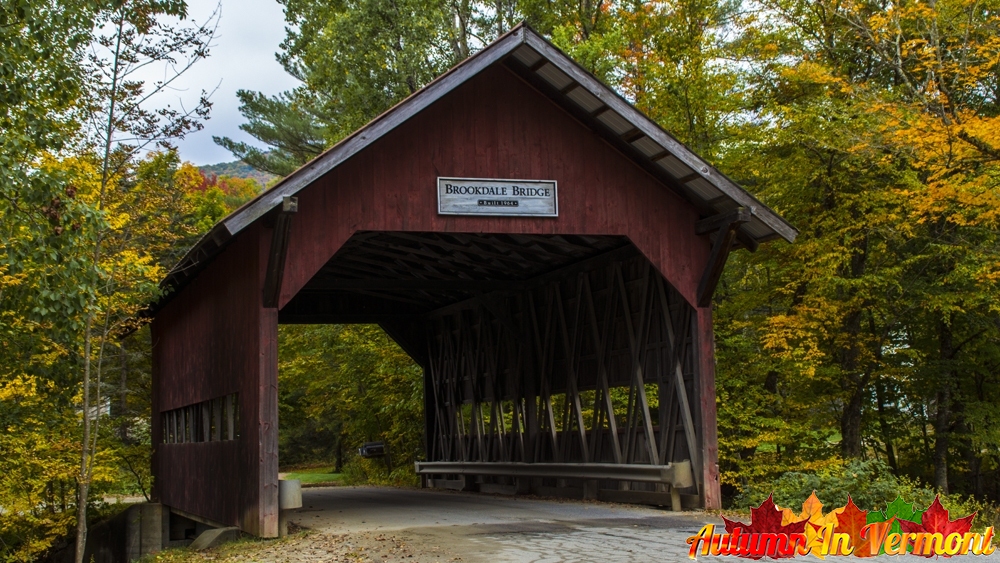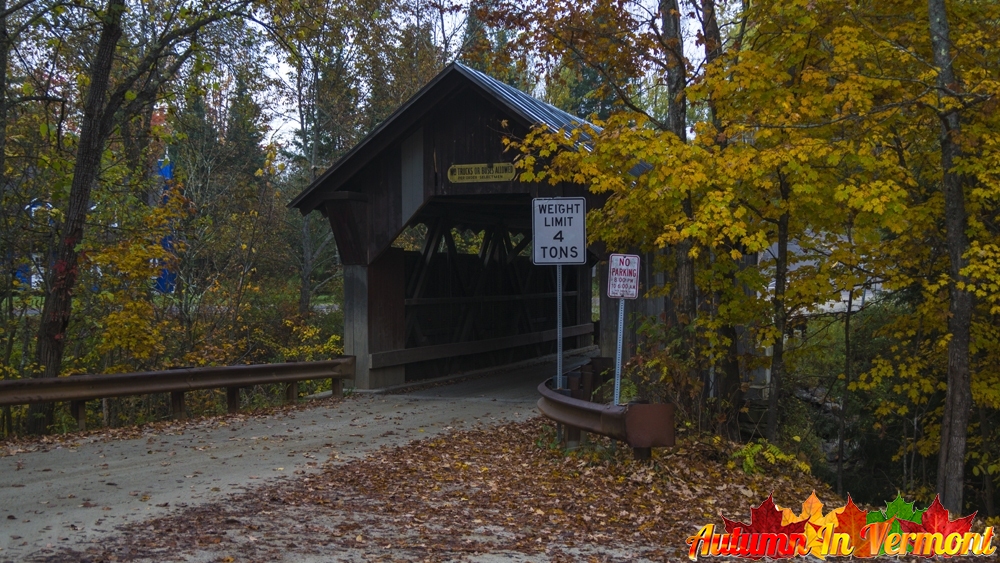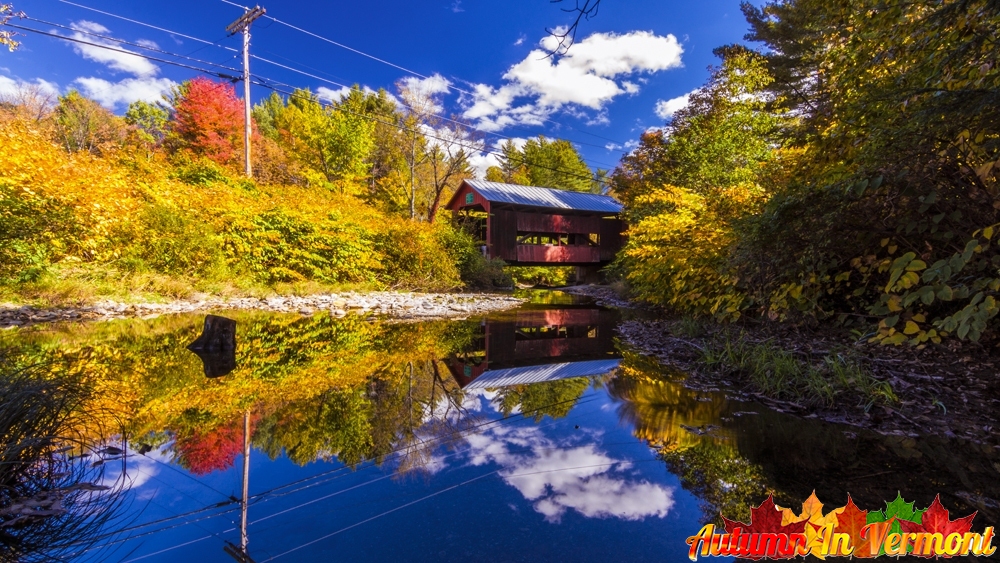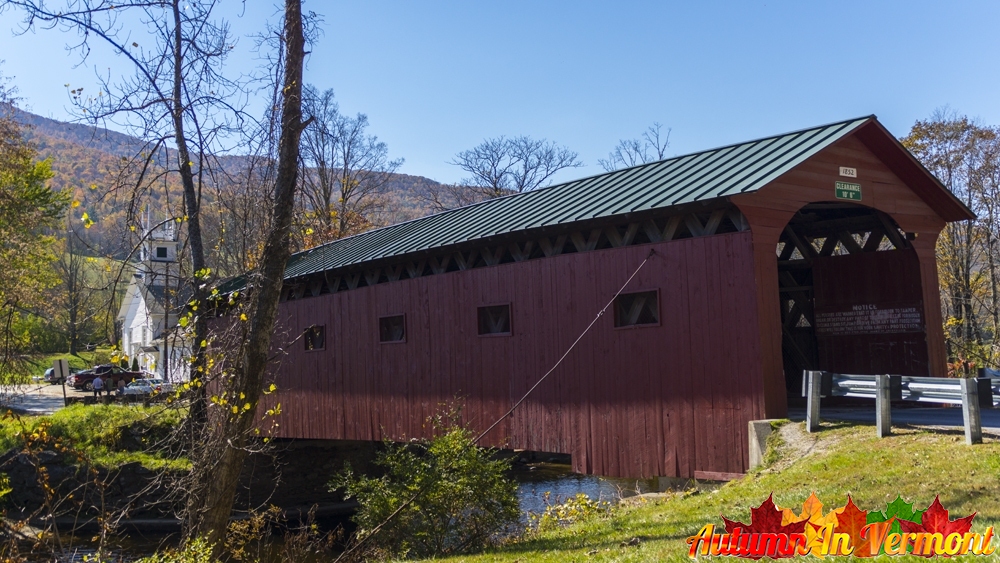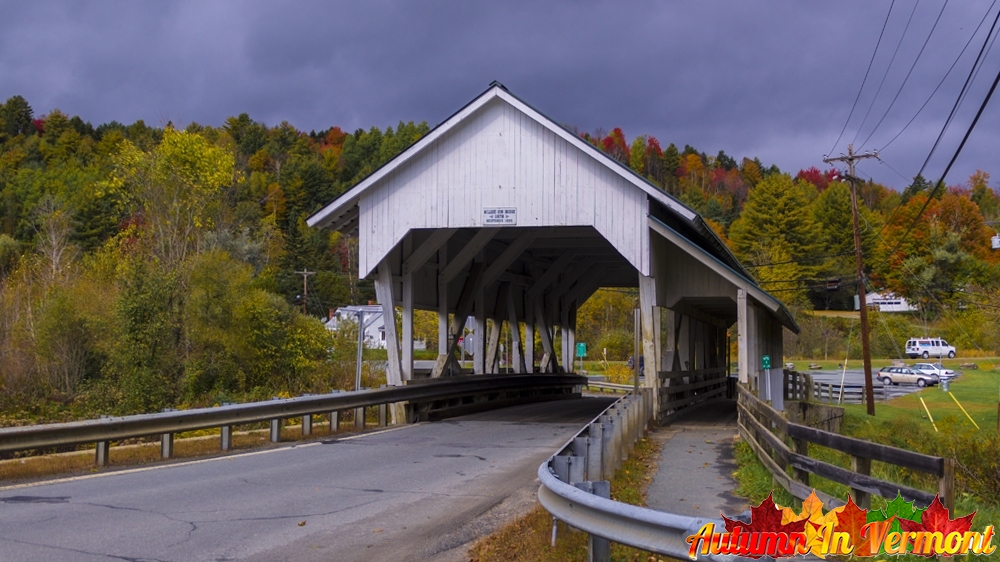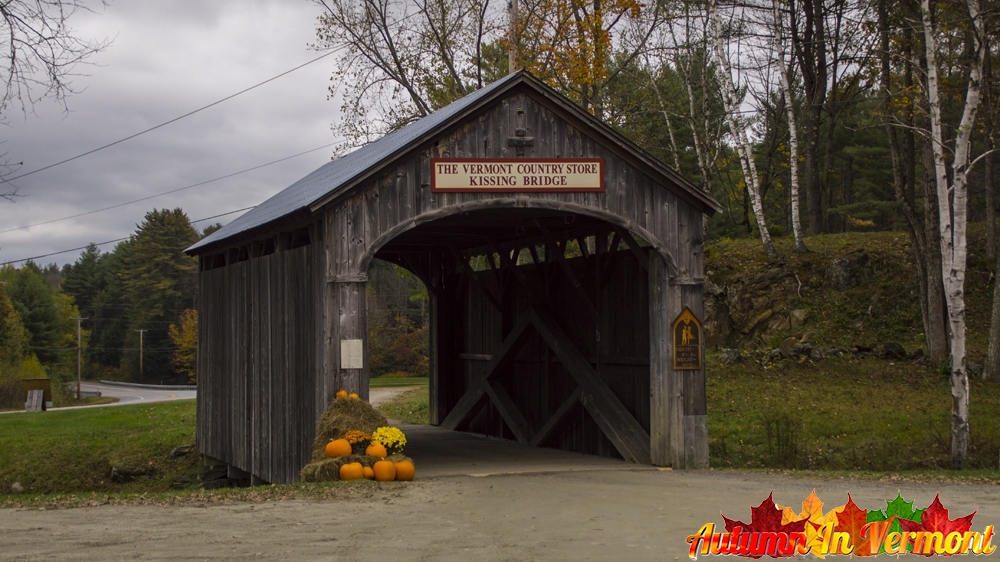| |
Middle / Union Street Bridge.
The Middle Bridge, rebuilt in 1969 by Milton Graton, carries Union Street over the Ottauquechee River. Town lattice truss; 139 feet long. Parking in the village along US 4.
Location: Off Route 4. Travel 0.1 miles west of the junction Route 12 North on US4, then just right on Union Street
| Comstock Covered Bridge.
The Comstock Covered Bridge is a wooden covered bridge that crosses the Trout River in Montgomery, Vermont on Comstock Bridge Road. Built in 1883, it is one of several area bridges built by Sheldon & Savannah Jewett.
Location: Comstock Bridge Road over the Trout River south of Vermont Route 118.
|
| |
Waitsfield / Big Eddy Bridge.
This bridge, built in 1833 and restored in 1975, is the oldest operating covered bridge in the state. It carries Bridge Street across the Mad River.
Location: E. of Route 100 on Bridge Street.
| Cilley / Lower Bridge.
The Cilley Bridge, built in 1883, carries Ward Hill Road over the First Branch of the White River. Multiple kingpost truss; 66 feet long. Parking on either side of the bridge.
Location: W. off Route 110. Travel 0.8 miles southwest of Tunbridge Village center on Route 110; then 0.2 miles right on Ward Hill Road.
|
| |
Warren Bridge.
The Warren Bridge, a prominent symbol of the Town of Warren, was built in 1880, and it carries Warren Village Road over the Mad River in Warren. Unique features of this structure are the different portal openings at either end of the bridge. Queenpost truss; 59 feet long. Parking available along Covered Bridge Road.
Location: E. of Route 100 on Warren Village Road.
| Moseley Bridge / Stony Brook Bridge.
The Moseley Bridge, built in 1899, carries Stony Brook Road over Stony Brook. During a reconstruction in 1971 steel girders were added. Kingpost truss; 39 feet long. Good parking area near the bridge on north side of Stony Brook Road.
Location: W. off Route 12A on Stony Brook Road. Travel 1.6 miles from the junction of Route 12 and Route 12A, then turn right on Stony Brook Road and travel 0.2 miles. Take a left, bridge is 0.7 miles.
|
| |
Taftsville Bridge.
The Taftsville Bridge, built in 1836 and one of the oldest covered bridges in Vermont, carries River Road over Ottauquechee River. Two-span multiple kingpost truss with an arch; 189 feet long; spans are 89 and 100 feet.
The original Taftsville Covered Bridge was destroyed by Huricane Irene (2011). It was replaced in September 2013.
Location: 0.5 miles west of the junction Route 12 on US4, then 0.1 miles right on River Road.
| Quechee Covered Bridge.
The original Quechee Covered Bridge was actually a steel bridge, constructed in 1970 as a 70 foot span over the Ottauquechee River in Quechee VT. It did look good, and the location is terrific. This bridge is a two-lane bridge complete with a pedestrian walkway alongside.
The original Quechee Covered Bridge was destroyed by Huricane Irene (2011). It was replaced in August 2013.
Location: Waterman Hill Road, Quechee, Hartford.
|
| |
Dummerston Bridge.
The West Dummerston Bridge, built by Celeb B. Lamson in 1872, carries East-West Road over the West River. Completely restored in 1998. Two-span Town lattice truss. Parking in lot near the bridge.
Location: Route 30 north 0.7 mile from West Dummerston; turn east on West Dummerston Covered Bridge Road. Travel 150 feet to the bridge.
| Brookdale Bridge.
Built for the Whitecaps Corporation Housing Development in 1964, Brookdale is a “stringer” covered bridge, meaning it was made with stringers instead of traditional style trusse.
Location: Brook Road in Stowe.
|
| |
Emily's (a/k/a Stowe Hollow, Gold Brook) Covered Bridge.
Built in 1844 to carry what came to be known as Covered Bridge Road over Gold Brook, “Emily's Bridge” is a single-lane, 50-foot-long bridge. Its wooden frame is dark and weathered, and it was here, if legend is to be believed, that a girl with a broken heart committed suicide.
Location: Covered Bridge Road, 1.2 miles up Gold Brook Road from Route 100.
| Upper Cox / Third Bridge.
The Upper Bridge, built about 1872, carries Cox Brook Road over Cox Brook. This bridge is only 0.2 miles from the Lower Bridge and 0.4 miles from the Station Bridge on the same road. This bridge is also known as the Third Bridge. Queenpost truss; 51 feet long. Good parking area near the bridge on south side of Cox Brook Road.
Location: W. off Route 12 on Cox Brook Road. The turnoff is to the west, at the main intersection in Northfield Falls, then 0.4 miles down Cox Brook Road. Cross Station and Lower Bridge and the bridge is visible.
|
| |
Arlington Green Covered Bridge.
It is a single span structure, with a length of 80 feet (24 m), a total width of 17.5 feet (5.3 m), and a roadway width of 14 feet (4.3 m) (one lane).
Location: The village of West Arlington, crossing Batten Kill just south of Route 313.
| Lower Cox Brook Covered Bridge.
The Lower Bridge, built about 1872, carries Cox Brook Road over Cox Brook. This bridge is also known as the Newell and Second Bridge. Queenpost truss; 55 feet long. Good parking area near the bridge on south side of Cox Brook Road.
Location: W. off Route 12 on Cox Brook Road. The turnoff is to the west, at the main intersection in Northfield Falls, then 0.2 miles down Cox Brook Road. Travel across Station Bridge and the bridge is visible.
|
Baltimore Bridge.
The Baltimore Bridge, built in 1870, was originally located in North Springfield. It was moved to its present location near the Eureka Schoolhouse in 1970. Town lattice truss; 37 feet long. This is a state-owned historic site.
Location: Next to Route 106.
| Kingsley Bridge.
The Kingsley Bridge, built in 1838, carries Congdon Road over Mill River. Town lattice truss; 135 feet long. A mill is located adjacent to the bridge a short distance downstream. Parking in pulloff near bridge.
Location: SW. off Route 103. Travel 0.2 miles east of the junction of US7B on Route 103 then right 1.2 miles on Airport Road and right again on River Road; then left on East Road 0.1 miles to the bridge.
|
Hall / Osgood Bridge.
Hall Bridge, built about 1867, was destroyed by a truck in 1980, and an authentic replacement was built in 1982. Town lattice; 120 feet long.
Location: Route 121 east 1.2 miles from junction with Westminster Street in Saxtons River, north on Sunderland Hill Road 200 feet to the bridge.
| Sayers / Thetford Center Bridge.
The Sayers Bridge carries Tucker Hill Road over the Ompompanoosuc River. Town lattice truss; 127 feet long. Parking is available on the south side of bridge.
Location: S. off Route 113A. Travel 2.2 miles northwest of junction I-91 on Route 113 (Exit 14); then 0.2 miles left on Tucker Hill Road.
|
Depot Bridge.
The Depot Bridge, built in 1840, carries Depot Road over the Otter Creek. Town lattice; 121 feet long. Parking in pulloff near bridge.
Location: 1.3 miles NW of the junction of Route 3 on US7 in Pittsford then left a half mile then left 0.3 miles on Depot Road.
| Best / Swallows Bridge.
The Best Bridge, built in 1889, carries Churchill Road over the Mill Brook. Tied arch; 37 feet long. Roadside parking.
Location: 1.3 miles southeast of the junction of Route 106 on Route 44; then 0.1 mile right on Churchill Road.
|
Millers Run Covered Bridge.
The Millers Run Covered Bridge is a historic covered bridge, carrying Center Street over Miller Run, a tributary of the Passumpsic River, in Lyndon, Vermont. Built in 1878, it was the last of Vermont's many 19th-century covered bridges to carry a numbered state highway.
Location: Central Street just south of its junction with Gilman Road. The latter carries Vermont Route 122 on the north side of Miller Run, while Central Street runs south to the downtown area.
| Halpin / High Bridge.
The Halpin Bridge, built in 1824, carries Halpin Road over Muddy Branch of the New Haven River. Town lattice truss; 66 feet long. Parking available on west side of the bridge.
Location: East off Route 7. Travel 0.1 miles southeast of junction of Route 30 on US7; then 1.3 miles left on Washington Street; then 1.6 miles left on Halpin Road; 0.3 miles right on dead-end road.
Silk Road / Locust Grove Bridge.
The Silk Bridge, built in 1840, carries Silk Road across the Waloomsac River. This bridge is a short distance from Paper Mill Bridge and the Henry Bridge. Parking in pulloffs on the north side of the bridge.
Location: US7 north 1.2 miles from junction with Route 9 in Bennington; northwest on Route 7A 0.8 miles; continue northwest on Route 67A and west 1.0 miles; south on Silk Road (opposite Bennington College); 0.2 miles to the bridge.
|
Gorham / Goodnough Bridge.
The Gorham or Goodnough Bridge, built in 1841, carries Gorham Bridge Road over the Otter Creek. Town lattice truss; 114 feet long. Parking in pulloff near bridge.
Location: About 2 miles south of the junction of US7 at Pittsford Mills on Route 3 then right on Gorham Bridge Road a half mile to the bridge.
| South Pomfret / Smith Bridge.
The Smith Bridge carries a private road over Mill Brook. This bridge was moved to its current location in 1973 when a bridge from Lamoille County was cut in half. The other half of this bridge was on the site of the Twigg-Smith Bridge in Brownsville. The Twigg-Smith Bridge was removed in 2001. Town lattice truss; 39 feet long. Park along road, property is posted for privacy.
Location: 1.1 miles north of junction US4 on Route 12; then 1.7 miles right on South Pomfret-Woodstock Road and walk 0.1 left on farm access. Farm is posted for privacy.
|
Slaughter House Bridge.
The Slaughter House Bridge, built about 1872, carries Slaughter House Road over the Dog River. Slaughter House Road was formerly named Bailey Road. Queenpost truss; 55 feet long. A small parking area is available on the left side of Slaughter House Road before crossing the bridge.
Location: Off Route 12 on Slaughter House Road, formerly Bailey Street. The turnoff is 0.3 miles south of the main intersection in Northfield Falls, then 0.1 miles down Slaughter House Road to the bridge.
| Cornwall-Salisbury Bridge.
The Cornwall-Salisbury Bridge is also known by the names Station Bridge, Creek Road Bridge, Cedar Swamp Bridge, and Salisbury Station Bridge. This one-lane bridge, built in 1865, carries Creek Road in Salisbury and Swamp Road in Cornwall over Otter Creek. Town lattice truss; 153 feet long. Parking in small lot near bridge.
Location: E. off Route 30. Travel 3.2 miles south of junction of Route 74 on Route 30; then 1.3 miles left on Swamp Road.
|
Howe Bridge.
The Howe Bridge, built in 1879, carries Bellnap Brook Road (also known as Hill Road) over the First Branch of the White River in South Tunbridge. Multiple kingpost truss; 75 feet long.
Location: E. next to Route 110. Travel 1.1 miles north Windsor County line on Route 110; then just right on Belknap Brook (Hill) Road.
| Henry / Burt Bridge.
The Henry or Burt Bridge crosses the Waloomsac River in Bennington. This bridge is a short distance from the rebuilt Paper Mill Bridge and the Silk Bridge. It was built in 1840 and rebuilt in 1989. Between those times, the bridge had two sets of town lattice trusses to handle the weight of heavy loads of pig iron drawn by oxen. This made the Henry bridge the strongest covered bridge in Vermont. Town lattice truss; 127 feet long. Parking along Murphy Road.
Location: South-southwest of North Bennington. Travel Route 67A south 1.2 miles from junction with VT67 in North Bennington; west on River Road; 0.5 miles south on River Road; 150 feet to the bridge.
|
Worralls Bridge.
The Worrall Bridge, built in 1868 by the Sanford Granger, carries Williams Road over the Williams River. Town lattice; 86 feet long. Parking on west side of bridge.
Location: From Lower Bartonsville Road go south 0.5 miles from Bartonsville; continue south on Route 103 0.4 miles; east on Williams Road; then 0.2 mile to the bridge.
| Downers / Upper Falls Bridge.
The Downers or Upper Falls Bridge, built in about 1840 and restored in 1975-76, carries Upper Falls Road over the Black River in Amsden. Town lattice truss; 120 feet long. Roadside parking.
Location: S. off route 131. Travel 0.3 miles west of junction of Route 106 on Route 44; then 0.1 miles left on Upper Falls Road.
|
Chiselville Bridge.
The Chiselville Bridge, built in 1870, carries Sunderland Hill Road over Roaring Branch Brook. The covered portion of the bridge is a town lattice truss and there is a center pier at mid span. It is worth the walk to go to the bottom of the ravine and view the bridge from below. Parking in pulloffs on the north side of the bridge.
Location: E. off Route 7. Travel east of Arlington, East Arlington Road east (curves north) 1.6 miles; continue north on Sunderland Hill Road; 0.4 miles to the bridge at Chiselville.
| Pulp Mill / Paper Mill Bridge.
The Cooley Bridge, built in 1849 by Nicholas Powers, carries Elm Street over the Furnace Brook. Town lattice truss; 53 feet long. Parking in pulloff near bridge.
Location: Old Pittsford, Proctor Road. Travel 1.1 miles northwest of the junction of Route 3 on US7 then left at the second turn on Elm Street; then 1.2 miles to the bridge.
|
Martin’s Mill / Martinsville Bridge.
The Martins Mill or Martinsville Bridge, built in 1881, carries Martinsville Road over the Lulls Brook. Town lattice truss; 135 feet long. Parking to the right before crossing the bridge.
Location: E. off Route 5. Travel 0.4 mile north of the junction I-91 on US5; then 0.6 miles right on Martinsville Road.
| Larkin Bridge.
The Larkin Bridge, built in 1902, carries Larkin Road over the First Branch of the White River. Multiple kingpost truss; 66 feet long. Parking available beyond the bridge.
Location: E. off Route 110. Travel 1.0 miles northeast of Tunbridge Village center on Route 110, then 0.1 miles right on Larkin Road.
|
Kingsbury / Hyde Hall Bridge.
The Kingsbury Bridge was built in about 1904 and is one of the newest of the historic covered bridges in Vermont. It carries Kingsbury Road over the Second Branch of the White River in South Randolph. Multiple kingpost truss; 46 feet long. Parking available on the Route 14 side of the bridge.
Location: W. next to Route 14. Travel 0.4 miles north of Windsor County line on Route 14, then just left on Kingsbury Road.
| Hammond Bridge.
The Hammond Bridge, built in 1843, carries Kendall Hill Road over the Otter Creek, but it is closed to vehicular traffic. During the Flood of 1927, the bridge floated more than a mile down Otter Creek. It was undamaged, and was towed back to his site on a barge of empty barrels. Town lattice truss; 145 feet long. Parking in pulloff near bridge.
Location: W. off Route 7. Travel 2.2 miles of the junction of Route 3 at Pittsford Mills on Route 7 past Pittsford then left 0.8 mile and just right to the bridge.
|
Williamsville Bridge.
The Williamsville Bridge, built by Eugene F. Wheller in 1870, is a 120-foot-long Town lattice truss. Parking on far side of bridge.
Location: Off Route 30. Dover Road east 1.7 miles from junction with North Street in East Dover to the bridge. The bridge is east of East Dover in the town of Newfane.
| Bowers / Brownsville Bridge.
The Bowers Bridge, built in 1919, carries Bible Hill Road over the Mill Brook in Brownsville. Tied arch; 45 feet long. Parking along the road.
Location: Off Route 44. Travel 1.1 west of main intersection in Brownsville on Route 44; then 0.2 right and 0.1 right on Bible Hill Road.
|
Union Village Bridge.
The Union Village Bridge, built in 1867, carries Academy Road over the Ompompanoosuc River. Town lattice truss; 111 feet long. Parking on the road before crossing the bridge.
Location: 2.4 miles northwest of junction of US5 on Route 132; then 0.5 miles right and just right on Academy Road.
| Willard / North Hartland / West Twin Bridge.
This bridge was built in 2001, a short distance down the Mill Road from the Willard Bridge. Town lattice truss; 80 feet long. Parking available to right before crossing the bridge.
Location: At US 4 and US 5, travel south on US 5 for 5 miles to the I-91 underpass; after the underpass, turn east onto Evarts Road; travel 0.1 mile to Mill Street; left onto Mill Street; 0.2 mile to the Willard Twin bridges
|
Sanderson / Lower Bridge.
The Sanderson Bridge, built in 1838, carries Pearl Street extension over the Otter Creek. Town lattice; 132 feet long. This bridge is no longer open to traffic. A steel bridge directly next to the Sanderson Bridge carries the traffic on Pearl Street. Parking in pulloff near bridge.
Location: South off Route 7 in Brandon off Pearl Street extension.
| Lincoln Bridge.
The Lincoln Bridge, built in 1865, carries Fletcher Hill Road over Ottauquechee River. This is a one-of-a-kind modified Pratt truss with an arch; 136 feet long.
Location: S. next to Route 4. Travel 3.1 miles west of junction Route 106 on US4; then left on Fletcher Hill Road. Visible from US 4.
|
Moxley / Guy Bridge.
The Moxley Bridge, built in 1883, carries Moxley Road over the First Branch of the White River in Chelsea. Queenpost truss; 59 feet long. Parking is available on either side of the bridge along the shoulder.
Location: E. next to Route 110. Travel 2.5 miles south of junction Route 113 on Route 110, then 0.1 miles left on Moxley Road.
| Twin Bridge.
The Twin Bridge, built in 1850, is on dry land and is not being used as a bridge. Originally a town lattice truss; 63 feet long. Parking available in town storage area near bridge.
Location: 1.3 miles north of the junction of Route 4 east on US7 in Rutland then 0.8 mile right and ahead on East Pittsford Road to the bridge on the east side of the road.
|
Victorian Village Bridge.
The Victorian Village Bridge is modified kingpost truss. The bridge span is 46 feet. Originally built in 1872, this bridge was dismantled and rebuilt in 1967. Privately owned. Parking at lot at Vermont Country Store.
Location: North of exit 6 on I-91, at the intersection of US 5 and Route 103, travel north on Route 103 for 2.5 miles. Bridge is an entrance to Vermont Country Store.
| Titcomb / Stoughton Bridge.
The Titcomb or Stoughton Bridge, built about 1880, carries a foot trail on a farm over the Schoolhouse Brook. Multiple kingpost truss; 48 feet long. Parking in school parking lot.
Location: S. off Route 106. Travel 0.3 miles south of the junction of Route 131 on Route 106; then 0.1 mile left, on a farm, across the street from Weathersfield Elementary School. Bridge is visible from highway.
Mill / Hayward / Noble Bridge.
The Mill Bridge, built in 1883, carries Spring Road over the First Branch of the White River. An ice jam destroyed the bridge on March 4, 1999, and the bridge was replaced in 2000. Multiple kingpost truss; 72 feet long. Parking on either side of the bridge.
Location: West off Route 110 in village. Travel 0.1 miles west of Route 110 and Tunbridge Village center on Howe Lane.
|
Gifford / C.K. Smith Bridge.
The Gifford Bridge was built in 1904 and is one of the newest of the historic covered bridges in Vermont. It carries Hyde Road over the Second Branch of the White River in East Randolph. Multiple kingpost truss; 46 feet long. Parking on either side of the bridge.
Location: 1.7 miles south of Route 66 on Route 14, then 0.1 miles left on Hyde Road.
| Coburn / Cemetery Bridge.
This bridge, built in 1851, crosses the Winooski River (formerly known as the Onion River). The trusses and structure are intact; the original deck has been replaced. Queenpost trusses; 70 feet long.
Location: NW off Route 2
|
Shoreham Railroad - Rutland Railroad Bridge.
The East Shoreham Railroad Bridge, built in 1897, carries an abandoned rail line over Lemon Fair River. Howe truss; 108 feet long. Parking in lot near bridge also used by fishermen. This is a state-owned historic site.
Location: Off Route 22A. Travel 2.7 miles north of junction Route 73 east on Route 30; then 2.8 miles east on Shoreham-Whiting Road; 0.7 miles on west side of road.
| Brown Bridge.
The Brown Bridge was built in 1880 by Nicholas Powers, who was famous for constructing these bridges. It carries Upper Cold River Road over the Cold River. Town lattice truss; 118 feet long. Parking in pulloff near bridge.
Location: E. off Route 7. Travel 0.4 miles south of the junction of US4 on US7, turn right and go 0.5 miles on Route 7B to North Clarendon, then 0.7 miles left to East River Road. Then 0.1 miles ahead to Cold River Road, then right 1.6 miles and left 0.3
|
Salmond Bridge.
The Salmond Bridge, built about 1875, carries Henry Gould Road over the Black River. This bridge was moved to its current location in 1986. Multiple kingpost truss; 53 foot long. Parking for the picnic area also serves a parking for bridge viewers.
Location: E. off Route 131. Travel 2.4 miles east of the junction of Route 106 on Route 131; then 0.1 mile left on old section of Route 131 on Henry Gould Rd.
| Paper Mill Village Bridge.
The Paper Mill Bridge, built in 1889, carries Murphy Road across the Waloomsac River. This bridge is a short distance from rebuilt Silk Bridge and the Henry Bridge. Town lattice truss; 125 feet long. Parking in pulloffs on north side of bridge.
Location: US 7 north 1.2 miles from junction with Route 9 in Bennington; then northwest on Route 7A 0.8 miles; continue northwest on Route 67A west 1.4 miles; south on Murphy Road; 250 feet to the bridge.
|
Pine Brook / Wilder Bridge
The Pine Brook Bridge, built in 1872, carries North Road over Pine Brook just outside Waitsfield. Its structure has never been altered and it is open to public use. Kingpost truss; 48 feet long. Parking available on the north side of North Road.
Location: E. off Route 100. From Village Bridge travel east on Bridge Street to Waitsfield Commons. Take a left on North Road; 1.2 miles to the bridge.
| Spade Farm / Old Hollow Bridge.
The Spade Farm Bridge crosses a farm pond and is used only for foot traffic. A sign on the bridge says it was built in 1824; some experts believe it was probably built in the 1850s. Town lattice truss; 85 feet long. Parking nearby in lot for Spade Farm.
Location: 3.9 miles north of junction Route 22A on west side of US 7.
|

